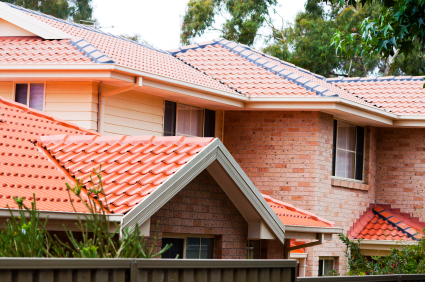Terracotta or fired clay tile has been used as a roofing material for thousands of years. Tiles were used in the Bronze Age in ancient Greece as early as 2500 B.C., in ancient Middle Eastern civilizations and in China in the Neolithic period approximately 10,000 years ago. Terracotta tile was commonly used as a roofing material by the ancient Greeks and Romans.

Tiles have been used as roofing on buildings in Europe from Roman times to the present. In some European cities like London, fired clay tiles were required because of their fireproof qualities. Early use of clay roof tiles in the United States has been documented at Jamestown and the settlement of Roanoke Island in 1585. Terracotta tiles were used on Spanish missions throughout Florida and the western states. Terracotta tiles are associated with specific architectural styles like Spanish Mission and Italianate Villa, but complement almost any building style.
Benefits of Terracotta Roof Tiles
Terracotta clay roof tiles are attractive, impermeable and durable. Terracotta is a natural material, made from clay that is fired at a high temperature until it vitrifies or fuses. Vitrification creates a hard, waterproof surface that withstands rain, snow, cycles of freezing and thawing and wears well in coastal areas with salt air. They are fireproof, last up to 100 years or more and are almost maintenance-free. Because they are made from clay, terracotta tiles are easy to recycle and do not harm the environment.
Clay roof tiles are traditionally red, which is a moderately reflective color. Light-colored roofs, also called cool roofs, have higher reflectance and emissivity than dark-colored roofs. More than 90 percent of the roofs in the United States are of dark-colored materials which are low-reflectance and can reach temperatures of 150 to 190 degrees F. Cool roofs stay cooler, sometimes as much as 70 degrees cooler than a dark-colored roof, resulting in lower energy costs and more comfortable building interiors.
With the interest in saving energy and using more environmentally sustainable building techniques, manufacturers have developed fired clay tiles that achieve higher reflectivity and emissivity indices. These tiles, available in many colors including the traditional red-orange terracotta, achieve cool roof values. Several manufacturers produce clay tiles that meet Energy Star specifications.
Clay tiles are made in three grades according to American Society for Testing and Materials (ASTM) specifications. Grade 1 tiles withstand severe freeze-thaw conditions and are not porous. They can be used anywhere in the United States. Grade 2 tiles withstand moderate freeze-thaw cycles and are less water-resistant. Grade 3 tiles are more permeable and may flake in freeze-thaw cycles. Grade 3 tiles are recommended for areas with mild climates like Florida and southern California.
ASTM sets values for transverse breaking strength for tiles of different profiles or curvatures. These values correlate with the ability of a tile to withstand stresses including severe weather, hail and handling and installation.
Some manufacturers apply glaze to tiles which adds color and additional surface protection. Glazed tiles are often untreated on the underside which reduces weight, expense in manufacture and allows the tile to breathe and expel moisture from the untreated surface. Many manufacturers provide guarantees against color fading for a specified number of years.
Terracotta tiles are available in several shapes that give a unique look to the roof architecture. There are several interlocking systems that ensure that the tiles protect the roof and remain in place. Each system has a required amount of overlap that connects tiles on either side, above and below to prevent moisture from seeping between the tiles.
Mission clay tiles, also called Barrel tiles and S-curved tiles, have a highly rounded curve which gives the traditional look to Spanish style buildings. Flat clay tiles, also called English Shingle or Closed Shingle, are used on several styles of buildings. Flat pan tiles with curved cover tiles were used on classic Doric order buildings like those in the Acropolis at Athens.
Disadvantages of Terracotta Roof Tiles
Installation of clay tiles requires experienced, trained contractors. Clay tiles are more difficult to install than other types of roof materials and must be properly installed to withstand rain, severe weather and cycles of freezing and thawing. Manufacturers recommend horizontal and vertical overlap values to ensure that water does not penetrate between the tiles. Tiles must be properly anchored to flashings and eaves to protect underlying roof material.
If clay roof tiles leak, the underlying roof structure can be damaged. Leaks can travel beyond the source of the breakage or gap, so when replacing tiles or repairing leaks it is important to examine adjacent areas.
Terracotta tiles are breakable. Once installed, tiles should be walked on with care. If roof access is required, tiles should be removed or boards placed across a span of tiles to distribute weight. The most common reason for breakage is from falling tree limbs.
Clay tile is not recommended for low-pitch roofs. Clay roof tiles can be heavy, so must have good roof and wall support. Some manufacturers offer light-weight clay tiles that weigh less than 600 pounds per square in compliance with many building code requirements for reroofing.
Costs can increase depending on the distance tiles are shipped from the manufacturing source to the consumer.
Tags: roofing, roofing materials, shingles, terracotta, tile
